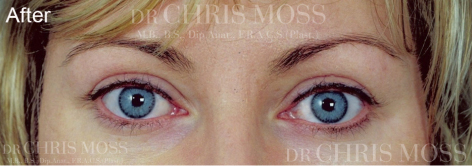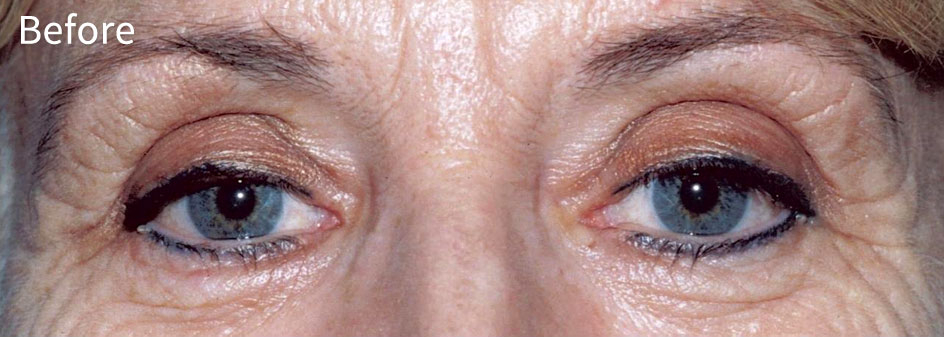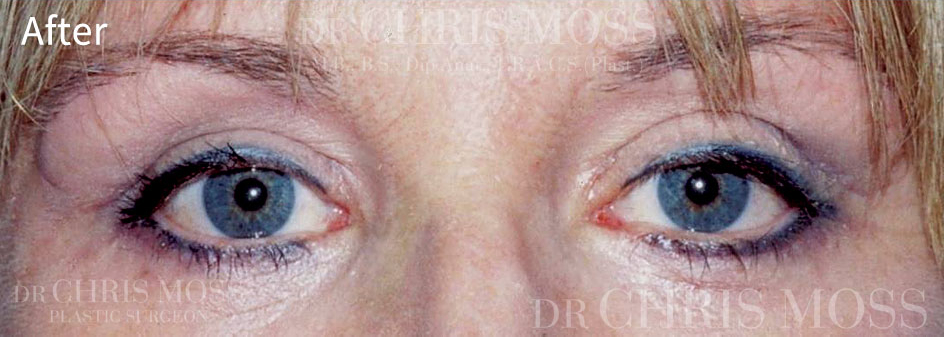Eyelid Surgery (Blepharoplasty)
Dr Moss regularly performs upper and lower eyelid surgery to address ageing and appearance concerns.
Disclaimer: Results vary from person to person. These images are indicative only and reflect the results for this patient. All surgery involves risks & recovery period – see below.

BEFORE
Area of Concern for Treatment:
- Genetic hooding of upper eyelid

AFTER
Surgery Performed
- Bilateral Upper Eyelid Blepharoplasty with Tarsal Fixation (to define upper lid crease)
The surgical result shown in the ‘After’ image addressed the listed Areas of Concern for Treatment.
Cosmetic Eyelid Surgery
Usually more than any other facial feature, the eyes have tremendous impact on your appearance. Most people consider their eyes to be their favourite feature. The most common concerns that patients present with are crepey or loose skin on the eyelids, lower eyelid fat bags and dark circles or hollowing under the eyes.
The appearance of the eyelids and lower eye area changes significantly with advancing age. In fact, the eyes are often the first place to show signs of ageing. Because the skin is so fine compared with the rest of the face the eyes are one of the first areas that people can develop wrinkles and loose skin.
Lower and upper eyelid fat bags and hollowing under or above the eyes can develop due to a number of variables including your genetics, facial shape and anatomy, and ageing changes such as the prolapse of eyelid fat bags, progressive loss of volume in the fatty layer beneath the skin.
Evolution of Blepharoplasty
Before modern cosmetic eyelid surgery techniques became available, the traditional approaches to blepharoplasty relied mainly on excision of skin and fatty tissues to firm and smooth the eyelids. Unfortunately, in an ill-advised attempt to treat more advanced signs of ageing, these techniques often resulted in excessive excision of skin and fatty tissues. This is known to significantly increase the risk of complications such as impaired eye closure, dryness of the eyes, malposition (drooping) of the lower eyelid, excessively hollowed eyes and an ‘operated look’.
Improved results have been made possible with the development of modern eyelid surgery principles and techniques. It is now well known that only the skin and fat that is in true excess should be removed so that all required tissues are carefully preserved. Modern cosmetic eyelid surgery options now combine more calibrated removal of skin and fat with technical advances that enable lower eyelid tightening, fat pocket repositioning, micro-fat grafting to replace lost volume and upper lid tarsal fixation blepharoplasty.
Surgical Options Available
Dr Moss provides a complete range of modern eyelid surgery options, and those performed most commonly by him are outlined below.
Upper Eyelid Surgery (Upper Lid Lift)
There are a number of techniques for upper eyelid surgery. Dr Moss will discuss with you the options that will suit you.
- Upper eyelid blepharoplasty also known as an upper eyelid lift, is performed via an incision placed within the upper eyelid crease. Only excessive skin and protruding fatty tissue are judiciously excised. This is the usual technique used for most people with concerns related to ageing. Incisions in this area heal well so the scar is usually fine and should not be socially detectible. After the surgical incision is healed it can be covered with eyelid makeup.
- Tarsal fixation upper blepharoplasty is performed via an incision placed in a location within the upper eyelid crease. This technique deals with excessive skin and protruding fatty tissue as in upper eyelid blepharoplasty, but also lifts and supports remaining upper lid skin by fixing the loose skin of the eyelid crease up onto the cartilage plate deep within the upper eyelid, creating crisper definition to the eyelid fold.
- Double eyelid surgery is performed on those, usually of Asian ethnicity, who are concerned about having a single eyelid, with or without puffy looking upper eyelids. This operation creates a double eyelid by re-defining the upper eyelid crease using advanced tarsal fixation eyelid techniques.
Lower Eyelid Surgery (Lower Lid Lift)
This is widely considered the more complex of the cosmetic eyelid surgeries and there is wide variation in the techniques used by different surgeons. In all lower eyelid surgery, it is vital to avoid excessive excision of skin in a misguided attempt to smooth the eyelid by tightening skin. Dr Moss places a priority on safety levels and natural looking results so all required lower lid skin is preserved as the highest priority. Dr Moss offers a full range of lower eyelid blepharoplasty techniques, the most common of which are described below. Each of these can be performed as a standalone technique, and all or any can be combined as needed to address each person’s individual presenting concerns.
- Transconjunctival lower eyelid blepharoplasty – performed via an incision inside the lower eyelid which is not visible. This is a treatment for those who have concerns about excessively prominent lower eyelid bags. The surgery includes removal and repositioning of excess lower eyelid fat. The most common age for this surgery is in the thirties and forties before ageing has caused significant skin excess.
- Transcutaneous lower blepharoplasty – also known as a lower eyelid lift, this is performed via an incision just below the lower eyelashes (a sub-ciliary incision). To achieve the desired results and address the different ageing concerns, Dr Moss may combine up to 4 synergistic surgical techniques in the one procedure. This may include calibrated skin smoothing by conservative skin excision, reduction of excessively prominent lower eyelid fat bags, and refilling of tear trough grooves by orbital fat repositioning. Lower eyelid firming by canthopexy is performed as required.
- Canthopexy – a support technique to provide extra firming of the lower eyelids and that also substantially reduces the risk of lower eyelid malposition when removal of significant degrees of excessive lower eyelid skin is performed at transcutaneous lower blepharoplasty. It involves the re-supporting of ligaments at the outer corner of the eyes that have become loosened due to the ageing process via a short incision under the eyelashes at the outer corner of the eye.
Ancillary Treatment Options
- Lower Eyelid Micro-fat Grafting – precise injection of fat to address concerns due to loss of volume in the layer under the skin such as tear troughs, hollowing under the eyes, and mid-cheek grooves.
- CO2 Laser Skin Resurfacing – laser treatment around the eyes to address concerns about fine lines and crepey skin.
- Anti-Wrinkle Injections – as neither surgery nor laser resurfacing will erase expression lines wrinkles, if these are of concern then muscle-relaxing anti-wrinkle injection treatments are available.
For more information on any of these eyelid surgery procedures do not hesitate to contact the Melbourne office.
What is the best age for Blepharoplasty?
There is no best age for blepharoplasty; but for ageing concerns this is usually performed from the forties and onwards, whereas for inherited concerns it is reasonable to perform surgery earlier.
For more information on any of these eyelid surgery procedures found below do not hesitate to
contact the Melbourne office.
Disclaimer: Results vary from person to person. These images are indicative only and reflect the results for this patient. All surgery involves risks & a recovery period – see below.

BEFORE:
Areas of Concern for Treatment
- Ageing of upper & lower eyelids

AFTER:
- Bilateral Upper & Lower Eyelid Blepharoplasty
The surgical result shown in the ‘After’ image addressed the listed Areas of Concern for Treatment.
Reconstructive / Corrective Eyelid Surgery
Dr Moss also performs corrective eyelid surgery for therapeutic correction of medical problems such as excess upper eyelid skin hanging over the eyelashes, sagging upper lids which can cause obstruction of the visual field (ptosis) and lower eyelid sagging (lid malposition). When necessary, Dr Moss can perform cosmetic and corrective eyelid surgery together at the same time.
The most common causes of functional problems requiring corrective eyelid surgery include ageing, cancer, trauma, birth defects and complications from previous (usually older) techniques of surgery. Reconstructive and corrective eyelid surgery is performed routinely by Dr Moss to treat the following medical problems:
- Ptosis (droopiness) of the upper eyelids
- Lower eyelid sagging (retraction) or malposition
- Ectropion (out turning) of the lower eyelids
- Repair or reconstruction of the eyelids following skin cancer removal or injuries
- Dry eye syndrome due to exposure
- Eyelid cancer removal
- Eyelid cysts (chalazion), lumps and bumps
Eyelid Surgery Results
Disclaimer: Results vary from person to person. These images are indicative only and reflect the results for each patient. All surgery involves risks & recovery period – see below.
Further Information about Eyelid Surgery and Recovery
Patients undergoing Eyelid Surgery may go home the same day or may stay a night or 2 in hospital, depending on the extent of surgery. Surgery is performed under General Anaesthetic. No dressings are required and sutures will be removed after 7 days. You can usually return to work and social life in by 2 weeks. You can return to light exercise by 2 weeks but refrain from more strenuous activity for 6 weeks.
Risks
All surgery has risks – no matter who performs the surgery. When surgery is performed by a trained and experienced plastic surgeon there will be measures and precautions put in place to help lower the risk of complications occurring. If complications do occur and require further treatment or revisional surgery, then a qualified surgeon is trained to manage such complications. During the consultation, Dr Moss will carefully explain the possible risks of your surgery so that you can make an informed decision.
Different patients will heal differently, and have different pain thresholds and will therefore experience different recovery times for different activities The following possible complications – which apply to all surgeons worldwide – are listed to inform you, rather than to alarm you. A number of these risks are rare and have not occurred to date in Dr Moss’ practice. Further details on the level of any risk in your particular circumstances, including the possible impact of any comorbidities you may have, are provided in your consultation.
All patients are likely to experience some temporary discomfort/pain, numbness or altered sensation around the incisions or operated areas; bruising and swelling; skin discolouration; lumpiness, tightness, fatigue, low spirits; and nausea – typically from the anaesthetics or pain killers, which may require treatment.
General risks of surgery include wound infection; haematoma, abnormal scarring, bleeding from the incisions, allergies or reactions to anaesthetic agents, medications, sutures or topical treatments, delayed healing or separation of wound edges.
Specific Risks of Eyelid Surgery include change in colour of the skin; appearance of tiny veins in skin or an acne breakout; change in or loss of vision; itchiness, watering or dryness of the eye(s); incomplete eyelid closure; swelling of the conjunctiva.
The risks of Anaesthesia include tooth damage; heart attack; blood clot in the leg or lung, and stroke. These are uncommon but could be life-threatening.



